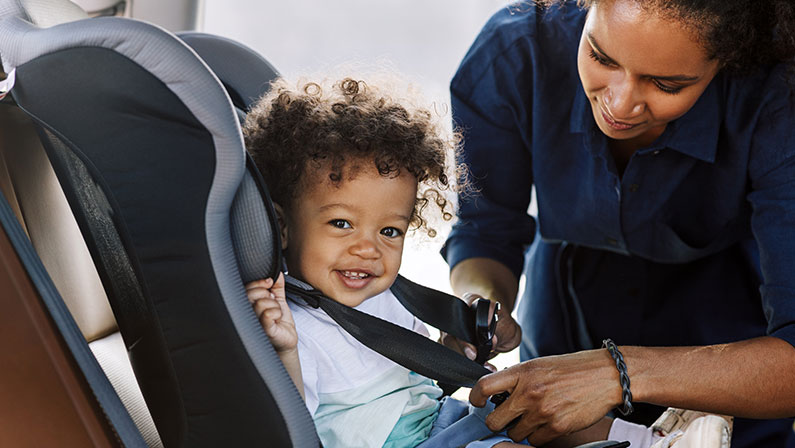Road injuries are the leading cause of preventable deaths and injuries to children in the United States. Correctly used child safety seats can reduce the risk of death by as much as 71 percent.
Engineers are working hard to ensure that cars and car seats are designed to keep kids as safe as possible. But it’s up to every parent to take full advantage of these innovations by making sure car seats and booster seats are used and installed correctly. Here’s what you need to know to ensure that your most precious cargo is safe in cars.
- Seventy-three percent of car seats are not used or installed correctly, so before you hit the road, check your car seat. Below is a quick car seat checklist to help you out. It takes only 15 minutes. If you are having even the slightest trouble, questions, or concerns, certified child passenger safety technicians are able to help or even double-check your work.
- Learn how to install your car seat for free. The Vanderburgh County Sheriff’s Office hosts car seat inspection events across the county where certified deputies can help make sure your car seat is properly installed. They will teach you so that you can always be sure your car seat is used correctly.
- Buy a used car seat only if you know its full crash history. That means you must buy it from someone you know, not from a thrift store or over the Internet. Once a car seat has been in a crash, it needs to be replaced.
- We know that when adults wear seat belts, kids wear seat belts. Be a good example and buckle up for every ride. Be sure everyone in the vehicle buckles up, too.
- Never leave your child alone in a car, not even for a minute. While it may be tempting to dash out for a quick errand, the temperature inside your car can rise 20 degrees and cause heatstroke in the time it takes for you to run in and out of the store.
Car Seat Checklist
- Right Seat. This is an easy one. Check the label on your car seat to make sure it’s appropriate for your child’s age, weight and height. Double-check the expiration date on your car seat label to make sure it is still safe.
- Right Place. Keep all children in the back seat until they are 13.
- Right Direction. You want to keep your child in a rear-facing car seat for as long as possible, usually until around age 2. When he or she outgrows the seat, move your child to a forward-facing car seat. Make sure to attach the top tether after you tighten and lock the seat belt or lower anchors.
- Inch Test. Once your car seat is installed, give it a good shake at the base. Can you move it more than an inch side-to-side or front to back? A properly installed seat will not move more than an inch.
Pinch Test. Make sure the harness is tightly buckled and coming from the correct slots (check car seat manual). Now, with the chest clip placed at armpit level, pinch the strap at your child’s shoulder. If you are unable to pinch any excess webbing, you’re good to go.
Please read the vehicle and car seat instruction manuals to help you with this checklist. If you are having even the slightest trouble, questions or concerns, certified child passenger safety technicians are waiting to help or even double check your work.
Choose the Right Direction
For the best protection, keep your baby in a rear-facing car seat for as long as possible – usually until about 2 years old. You can find the exact height and weight limit on the side or back of your car seat. Kids who ride in rear-facing seats have the maximum protection for the head, neck and spine. It is especially important for rear-facing children to ride in a back seat away from the airbag.
When your children outgrow a rear-facing seat around age 2, move them to a forward-facing car seat. Keep the seat in the back and make sure to attach the top tether after you tighten and lock the seat belt or lower anchors. Use the top tether until your child weighs 40 pounds. After February 2014, your car seat labels will tell you exactly how much your child can weigh and still use the lower anchors and top tether. Until then, check both your child restraint and vehicle manuals to see if you can go beyond the weight limit for the top tether. If they both agree to a higher weight, it is fine to follow their directions.
Kids can remain in some forward-facing car seats until they’re 65 to 80 pounds depending on the car seat limits. Check the seat label to find the exact measurements. Discontinue use of the lower anchors or top tether when your child reaches the limits set by your car seat and car manufacturers. You must read the manual to know about those limits. You will then switch to a seat belt that goes through the car seat at that time. Seat belts are made to protect very heavy adults as well as smaller children.
Check the Label
Look at the label on your car seat to make sure it’s appropriate for your child’s age, weight and height. Your car seat has an expiration date – usually around six years. Find and double check the label to make sure it’s still safe.
Is it time for a booster seat?
Take the next step to a booster seat when you answer “yes” to any of these questions:
- Does your child exceed the car seat’s height or weight limits?
- Are your child’s shoulders above the car seat’s top harness slots?
- Are the tops of your child’s ears above the top of the car seat?
If the car seat with a harness still fits, continue to use it until it is outgrown. It provides more protection than a booster seat or seat belt for a small child.
Be Wary of Toys
Toys can injure your child in a crash, so be extra careful to choose ones that are soft and will not hurt your child. A small, loose toy can be dangerous and injure your baby in a crash. Secure loose objects and toys to protect everyone in the car.
Child Safety Seat Program
The goal of the Vanderburgh County Sheriff’s Office Child Safety Seat Program is to ensure all children in our community have the opportunity to obtain a safe means of travel. The program is specially designed to assist the parents and guardians of children who are financially unable to obtain a certified child safety seat.
The Child Safety Seat Program was established at the Vanderburgh County Sheriff’s Office in 2005. The Sheriff’s Office currently has four certified Child Passenger Safety Technicians available. Each technician must complete a 40-hour certification and must re-certify every two years.
If you are in need of a child safety seat, please contact the Sheriff’s Operations Center at 812-421-6201 to set up an appointment with one of our technicians. Our technician will contact you and determine if you qualify for the program. An appointment will be set for you to come to the Sheriff’s Operation Center and have the child safety seat installed. The process normally takes 30 minutes.
For those individuals who are stopped for a violation of the child safety seat law, many deputies have state car seat vouchers to give out. With these vouchers, individuals will be able to visit the Sheriff’s Operations Center (with appointment) and obtain a new car seat.
Inspection
Families or individuals who already have a child safety seat (but are unsure how to install it correctly) may contact our office at (812) 421-6201 and ask to make an appointment with one of our technicians.
Updated 09.15.2024


